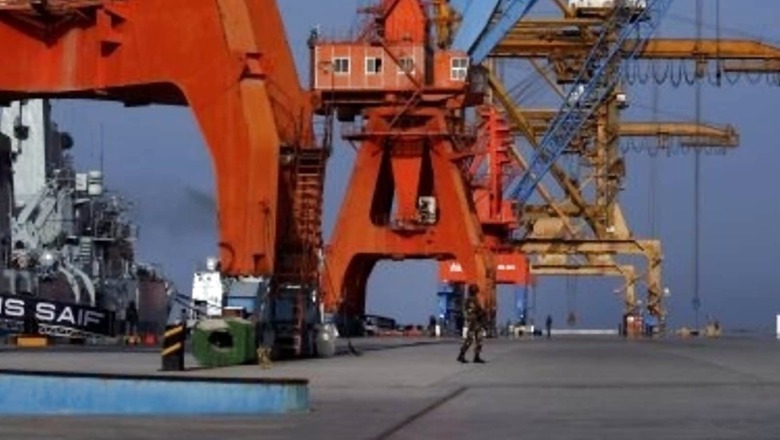
views
When the China-Pakistan Economic Corridor (CPEC) was launched in April 2015, the event was highlighted as a history-defining development for Pakistan. It was echoed that the CPEC projects would change the destiny of the nation. The makers behind the corridor expected that the corridor would add 2.5% more to Pakistan’s growth rate annually.
Pakistan is synonymous with energy shortage and long outages but the Pakistani establishment hoped that once CPEC was done, its energy projects will not only cover Pakistan’s power needs but will also generate extra energy available for export.
The lower-middle-income country, facing problems of poverty and unemployment, had also hoped that through these CPEC projects, it would see 2.3 million jobs by 2030 – putting Pakistan on the path of growth and social empowerment.
But six years down the line, all those big fairytale hopes seem to have vanished.
The current phase of CPEC is largely running behind schedule. Out of the 15 CPEC projects that are facing completion deadlines now, just three have been completed, while Pakistan, so far basking in the glory of the completion of the first phase of the CPEC projects from 2015 to 2018, is staring at yet another crisis that is deepening.
Loans from China are not coming for new and ongoing projects. Non-payment of around PKR 300 billion ($1.59 billion) to the Chinese companies already operational under CPEC has become a sour point. Add to it, the deep economic distress that the nation is facing – in running its economy and paying debt instalments annually.
CPEC suddenly has started looking like a massive debt behemoth even for Pakistanis, a notion that many in the world have always believed in.
Riding on Chinese loans, CPEC progressed well initially. On an overall corridor progress basis, Khalid Mansoor, special assistant to the Prime Minister on CPEC affairs, informed in September 2021 that 21 projects worth $15.2 billion were completed and another 21 worth around $9.3 billion were under operation.
But all that sounds good about CPEC ends here. Pakistan, in a deep economic crisis, cannot support ongoing or future CPEC projects, at least for two years, as many analysts say. But this duration may get even longer given the kind of situation the country is in.
Pakistan has a massive $130 billion foreign debt and the country needs $14 billion a year as annual debt instalments (principal + interest). But given the situation, after Sri Lanka, Pakistan may be the next country in Asia to default on foreign debt.
Foreign exchange reserves are down by over 60%, from $20 billion in August 2021 to $7.5 billion now. So, the country doesn’t have enough money in its forex reserves to pay for its annual debt instalments. According to the State Bank of Pakistan figures, the country has to pay $1.653 billion in FY2022 Q1 (principal + interest), $4.357 billion in FY2022 Q2, and $4.875 billion in FY2022 Q3.
Combine it with the fact that Pakistan is an import-dependent economy. But with the current forex level, its imports cannot go beyond one month and some more days. Therefore, Pakistan certainly is not in a position to help fund CPEC projects anymore, particularly when the 90% of funds China is supposed to give for every project are not coming.
China is facing its own set of problems. A resurgent Covid outbreak and lockdown in many parts of China including Shanghai have slowed down economic growth and the country is taking a hard stand on Pakistani loans, their repayment, and further loan demands, including towards CPEC projects. The situation is further complicated by attacks on Chinese workers and CPEC properties in Pakistan. Moreover, China is blaming Pakistan for the crisis and asking it to first come out of insolvency.
That leaves only one option available to Pakistan to escape this crisis – an IMF bailout. In fact, China, Saudi Arabia, and UAE, the three big lenders to Pakistan apart from multilateral agencies like the World Bank and the IMF, are recommending that Pakistan should go for it.
But can Pakistan go for it, when the conditions associated with the IMF bailout mean the country needs to put more burden on the public? IMF conditions mean Pakistan needs to raise diesel prices by 35%, petrol prices by 14%, and remove $1.5 billion towards annual subsidy on fuel. Following IMF practices means increased taxes and energy tariffs.
Pakistan’s politics is certainly not in a position to accept it. The Pakistani rupee has gone to its lowest level, touching a record low 202 against the US dollar. This year, the Pakistani rupee has seen a 22% depreciation. Pakistan has witnessed three years of double-digit inflation that is currently above 13% and going up.
The end victim is always the common citizens in these situations and Pakistan’s political establishment can’t take the risk of burdening them with more taxes and increased prices when the next elections are just around 12 months away.
That means Pakistan is not in a position even to get the IMF bailout loans.
This in turn means Pakistan has no other option but to look for other loans, even commercial ones, to meet its international debt obligations and import needs. This would cause more addition to the $130 billion pressure. So Pakistan will not be financially capable to participate in the CPEC projects and the period may well go beyond two years given the political instability and current debt burden on the country.
Read all the Latest News here




















Comments
0 comment